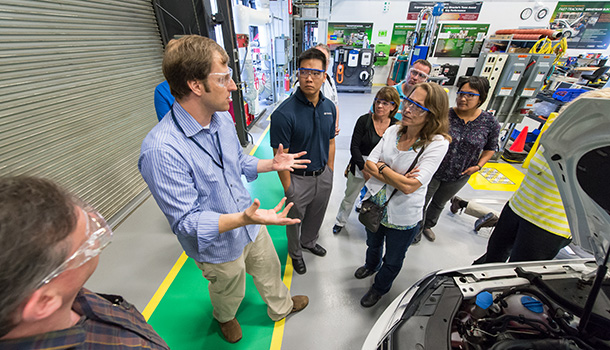
(Photo: Argonne National Laboratory)
A talented and adaptive workforce is the closest thing to a cure for growing economic insecurity and declining upward mobility. It also is a potent inoculant against disruptions from new technologies, foreign competition and other macroeconomic factors.
Over the last eight years, the California Economic Summit has partnered with business, government and civic organizations to align regional workforce priorities with state policies. Significant new investments are flowing through new programs designed to sync curricula with the needs of employers and the requirements of in-demand jobs.
The most powerful insight from these efforts is the imperative of building partnerships among colleges, workforce development agencies and regional employers to drive system change and outcomes. Durable public-private relationships are essential to understanding, meeting and adapting to the complex and changing needs of Californians – as students and workers, employers and entrepreneurs.
California’s colleges and workforce agencies are at an inflection point. Significant new investments are not yet producing the required results. While economists casually remark that regional economies are at “full employment,” millions of Californians are unemployed, underemployed or stuck in low-wage jobs that don’t cover food and rent. And whatever is around the next corner, the system is not ready to serve well those who will need even more help.
To better serve and be prepared, workforce partners must smartly collaborate on three priorities:
1. Drive investments toward outcomes.
Billions of additional dollars have been allocated to education, and skill-based learning in particular. The state has built an infrastructure and funded programs to improve student success. The CA Community College Chancellor’s Office has developed Guided Pathways to help each student select a path, pursue a planned curricula and receive necessary support.
From the Summit’s experience, these “internal” improvements will be most successful when linked with deep employer partnerships that align needed skills and provide early learning opportunities to ensure students are on the right path. The partners can include social service agencies that can recruit individuals who may not be considering additional training, and provide the services that are beyond the scope of colleges and workforce agencies.
California Forward, as the managing partner of the Economic Summit, is working with the Chancellor’s Office to document the most effective partnerships and their characteristics, with the expectation of developing models that can inspire and guide replication in other sectors and regions.
2. Act as if the “future of work” is now – because it is.
In 2018 CA Fwd, in partnership with the Chancellor’s office, convened hundreds of community and business leaders from 14 diverse regions to discuss the future of work – the dynamic, fascinating and, at times, unsettling future of work. Governor Brown’s Online Community College proposal was offered as a way to increase access to skills training for the 2.5 million young adults who have little more than a high school diploma and have not taken advantage of the state’s low cost and extensive network of traditional brick-and-mortar colleges.
The feedback was consistent: The online college would be an asset if it provided strong student support and if students had the technology and broadband access.
The online college also could equally benefit students, employees and employers. With a competency-based structure uncoupled from the semester calendar, employers can more easily partner with colleges to up-skill current employees or provide guidance on industry-valued credentials for current and anticipated positions.
In addition to technology, California needs to re-engineer financial aid for life-long learners.
Many Summit partners are engaging in legislative discussions – such as SB 291 – to adapt financial supports intended for traditional students to meet the needs of low-income students seeking certificates. But more comprehensive changes are needed to link financial aid and performance-oriented reforms so individualized educational plans can be quickly completed to reduce education and living expenses.
Over time, even more holistic changes will be required to ensure education and workforce development funding is available for future students, workers and adults who must work and learn to stay employed and keep careers on an upward track.
California also needs to rethink the architecture for gig/informal workers. An estimated one-third of Californians are doing “gig work.” This irregular employment is skewed toward the young, women, minorities and low-income households. This new “social contract” puts workers at a disadvantage and undervalues their contributions. Skilled web-designers, translators and coders often do well in this new world, while retail, warehouse, tourism and construction workers often do poorly.
Summit participants are exploring new technologies and applications can level the playing field for workers, creating opportunities for higher wages and encouraging additional skill development.
3. Focus on the hard to serve
This third priority is both obvious and often forgotten. Leading up the 2018 Summit, USC fellow Mark Pisano blogged on several key drivers described in his book: The Puzzle of the American Economic; How Changing Demographics Will Affect our Future and Influence Our Politics.
Pisano’s most salient takeaway: “No One is Disposable.” The 700,000 “disconnected” young adult Californians who are not in school or employed; the 510,000 Californians in jail or prison, on probation or parole; the 860,000 Californians who are employed part-time and say they want full-time work.
In 2018 the Summit prototyped a CA Dream Index to promote the need for official metrics to measure and link the primary drivers of economic security. In 2019, the Summit will work with the Newsom administration to refine and advance that proposal.
The recommendations in the Summit’s Roadmap to Shared Prosperity – from early learning through life-long learning, housing and water, rural economic development and Opportunity Zones – puts the forgotten first. It is imperative to elevate those who have been left behind. For social, economic and fiscal reasons, everyone must have the opportunity to participate in the economy and their communities.
Jim Mayer is President and CEO of CA Fwd

